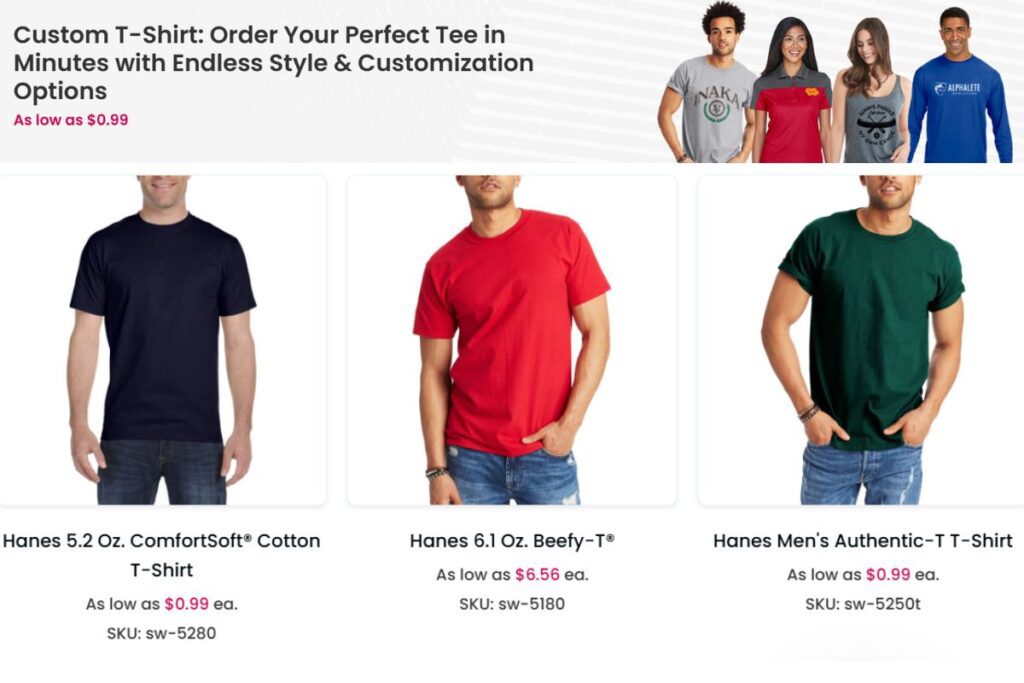Starting an online store can be exciting, but finding the right products to sell is crucial for your success.Sourcing products to sell online involves identifying reliable suppliers and selecting items that can attract customers.
Whether you are looking at manufacturers, wholesalers, or dropshipping options, knowing where to find your products is key to sustaining your eCommerce business.
In today’s digital world, many businesses utilize online B2B marketplaces, making it easier to connect with suppliers.
Table of contents
- Understanding Product Sourcing
- Starting with Market Research
- Finding Suppliers and Manufacturers
- Analyzing Supply Chain Management
- Evaluating Ecommerce Platforms
- Customization and Private Labeling
- Understanding Legal Considerations
- Assuring Product Quality
- Maintaining Effective Communication
- Optimizing Cost and Profitability
- Exploring Innovative Sources
- Strategies for Seasonal and Bulk Purchasing
- Frequently Asked Questions
- What are the best strategies for sourcing products to sell online?
- Where can I find a reliable product sourcing agent?
- How can one identify the most sellable products for online retail?
- What are the top product sourcing methods for online businesses?
- Which online platforms are ideal for purchasing inventory to sell?
- What steps are involved in becoming a professional product sourcer?
You can find products by doing research, attending trade shows, or exploring local businesses. Each method has its own advantages and can help you discover valuable items that fit your store’s theme and customer preferences.
Successful product sourcing can help you save costs and increase profits. By understanding the market and building good relationships with suppliers, you can secure quality products at competitive prices. This can lead to higher sales and customer satisfaction, essential elements for thriving in the competitive online marketplace.
Understanding Product Sourcing
Product sourcing is a key step in building a successful online store. It involves finding the right products and suppliers to meet your business needs.
This section will define product sourcing, discuss its importance in e-commerce, and overview the common methods you can use.
Definition of Product Sourcing
Product sourcing refers to the process of acquiring products to sell in your online store. You identify, assess, and choose suppliers who can provide your desired products at competitive prices.
This process can include researching different suppliers, negotiating prices, and placing wholesale orders. It is essential to consider both product quality and reliability of the supplier. Strong product sourcing can help you maintain inventory and ensure customer satisfaction.
Importance of Sourcing in Ecommerce
Effective product sourcing is crucial for your e-commerce success. It can directly affect your profit margins, inventory management, and customer satisfaction.
By sourcing the right products, you can meet market demand and stay competitive.
High-quality products enhance your brand reputation and encourage repeat purchases. Additionally, proper sourcing helps minimize overhead costs. This can lead to better pricing strategies and happier customers.
Sourcing Methods Overview
There are several methods for sourcing products as an online seller. Here are some common approaches:
Wholesale Suppliers: This involves purchasing products in bulk at discounted prices. You then sell them at a markup.
Dropshipping: In this method, you partner with suppliers who handle inventory and shipping. You only pay for products after you make sales.
Manufacturers: Some sellers choose to work directly with manufacturers to create custom products or buy in bulk.
Local Markets: Sourcing from local suppliers or trade shows can be a great way to find unique items.
By understanding these sourcing methods, you can choose the right strategy for your e-commerce business.
Starting with Market Research
| Source | Why It’s a Great Choice |
|---|---|
| Alibaba | Ideal for bulk sourcing directly from manufacturers at low costs. |
| AliExpress | Great for dropshipping with no need for bulk purchases. |
| SaleHoo | A verified supplier directory with high-quality wholesalers and dropshipping options. |
| Printful | Best for print-on-demand products like custom apparel, accessories, and home decor. |
| CJ Dropshipping | Offers worldwide warehouses and automation for dropshipping businesses. |
| Faire | Connects with independent brands and wholesale suppliers for unique products. |
| Etsy Wholesale | Perfect for sourcing handcrafted and vintage products in bulk. |
| ThomasNet | Ideal for U.S.-based businesses looking for domestic manufacturers and suppliers. |
| Amazon FBA Wholesale | Allows you to resell popular branded products with fulfillment by Amazon. |
| Local and Niche Manufacturers | Excellent for exclusive, custom, or small-batch product sourcing. |
Market research is the first step in sourcing products to sell online. It helps you find trending products, understand your target market, and use tools to gather valuable insights. This will set a solid foundation for your business decisions.
Identifying Trending Products
To find products that are currently in demand, you need to identify trends.
Start by searching online marketplaces like Amazon, eBay, and Etsy. Look at their best-seller lists to see what items are popular.
You can also check social media platforms like Instagram and TikTok. Influencers often showcase trending products, giving you good insights into consumer interests.
Create a list of potential products that catch your attention. This list will guide your sourcing efforts and help you focus on items with higher sales potential.
Analyzing the Target Market
Knowing your target market is crucial for your success. Ask yourself key questions: Who are your customers? What do they want?
Use surveys to gather feedback from potential buyers. This can help you learn about their needs, preferences, and pain points.
Additionally, analyze competitors to see who is already serving your target audience. Understand their strengths and weaknesses. This insight will help you tailor your offerings to better meet customer demands.
Using Tools like Google Trends
Google Trends is a powerful tool for learning about what people are searching for online. It allows you to see the popularity of specific products over time.
Start by typing in keywords related to your product ideas. Look for patterns in search volume. If interest is rising, it may be time to consider that product.
You can also compare multiple terms to see which ones are more popular. This can guide your decisions on which products to source.
Make it a habit to check Google Trends regularly to stay updated on market shifts.
Finding Suppliers and Manufacturers

Sourcing products to sell online requires a strategic approach to finding the right suppliers and manufacturers. You can enhance your success by working with wholesalers, engaging directly with manufacturers, or exploring online marketplaces.
Working with Wholesalers
Wholesalers are a great option for finding products at lower prices. They buy in bulk and sell to retailers. By partnering with a wholesaler, you can access a wide range of products without needing to invest in large quantities.
- Research Local Wholesalers: Start by searching for wholesalers in your area or specific industries.
- Evaluate Quality: Request product samples to assess quality before committing to an order.
- Negotiate Terms: Discuss pricing, minimum order quantities, and return policies to ensure a good deal.
Benefits of working with wholesalers include lower costs and faster shipping times. However, you need to manage inventory effectively.
Engaging Manufacturers Directly
Connecting directly with manufacturers can provide better pricing and unique products. This approach may require more effort, but it can lead to long-term partnerships.
- Identify Suitable Manufacturers: Use platforms like Alibaba or Global Sources to find manufacturers that specialize in your desired products.
- Ask for Samples: Before placing a bulk order, obtain samples to test the quality and fit for your brand.
- Discuss Customization Options: If needed, talk about product customization, which can help set your offerings apart from competitors.
Direct engagement allows for better communication and understanding of manufacturing capabilities, ensuring you get exactly what you want.
Exploring Online Marketplaces
Online marketplaces serve as a convenient option for sourcing products. Websites like Alibaba and Global Sources connect you with numerous suppliers globally.
- Filter Options: Use filters to narrow down your search based on product type, location, and supplier ratings.
- Read Reviews: Check reviews and ratings from other buyers to gauge reliability and product quality.
- Compare Pricing: Analyze different suppliers to find the best prices and terms for your needs.
This method offers a diverse range of products and allows you to source goods without geographical limitations. Be mindful of shipping times and potential customs fees when ordering internationally.
Analyzing Supply Chain Management
| Supply Chain Stage | Key Factors | Challenges | Best Practices |
|---|---|---|---|
| Product Sourcing | Selecting reliable suppliers, pricing, and product quality | Quality control, MOQ (Minimum Order Quantity) issues | Vet suppliers, order samples, and use multiple sourcing platforms |
| Inventory Management | Stock level optimization, demand forecasting | Overstocking, stockouts, high holding costs | Use inventory management software and real-time tracking |
| Logistics & Shipping | Warehousing, fulfillment, shipping methods | High costs, delays, customs issues | Partner with fulfillment centers and offer multiple shipping options |
| Supplier Relationships | Long-term partnerships, negotiation, contract terms | Supplier reliability, production delays | Build strong supplier relationships and maintain open communication |
| Quality Control | Ensuring product meets standards, handling returns | Defective products, customer dissatisfaction | Regular inspections, quality testing, and return policies |
| Cost Management | Reducing procurement, storage, and transportation costs | Hidden fees, currency fluctuations | Compare multiple suppliers and negotiate bulk discounts |
| Technology Integration | Using automation, AI, and data analytics | Implementation costs, learning curve | Utilize ERP systems and automated order tracking |
| Sustainability & Ethics | Eco-friendly materials, ethical labor practices | Compliance with regulations, higher costs | Choose sustainable suppliers and follow fair trade practices |
| Customer Satisfaction | Fast delivery, accurate order fulfillment | Delayed shipping, damaged products | Provide tracking, easy returns, and excellent customer support |
| Risk Management | Handling supply chain disruptions | Natural disasters, geopolitical issues, supplier failures | Diversify suppliers, maintain buffer stock, and have contingency plans |
Managing your supply chain is crucial for selling products online. Key areas to focus on include inventory management and order fulfillment. These elements can affect your efficiency and customer satisfaction.
Assessing Inventory Management
Effective inventory management helps you keep track of your stock levels.
Regularly monitor what items are selling well and which are not. Use tools like inventory management software to automate tracking. This reduces errors and saves time.
Consider the reorder point for each product. This is the stock level that signals when you need to place new orders.
Keeping updated inventory data prevents stockouts or overstocking, both of which can hurt your sales.
Regular audits also help maintain accuracy. Schedule checks to ensure that physical stock matches your inventory records. This practice helps avoid lost sales and increases your profit margins.
Understanding Order Fulfillment
Order fulfillment is how you deliver products to your customers. You have several fulfillment methods to choose from.
Fulfillment by Amazon (FBA) is a popular choice, allowing you to store products in Amazon’s warehouse. They handle shipping and customer service for you.
You may also consider self-fulfillment. This means you manage the entire process, from packing to shipping. This method offers more control but requires more time and resources.
A clear order fulfillment strategy is important. Make sure it aligns with your shipping goals and customer expectations.
Provide several shipping options for buyers, like standard and expedited delivery. The right strategy can enhance customer satisfaction and drive repeat business.
Evaluating Ecommerce Platforms

When selecting an ecommerce platform, understanding the differences between services can help you make informed decisions. Key aspects to consider include costs, features, and ease of use, which are critical to your business success.
Comparing Shopify vs Amazon
Shopify and Amazon serve different needs.
Shopify is a customizable platform that lets you build your own online store. You pay monthly fees and transaction costs but gain full control of your brand and customer experience. It’s ideal for businesses that want a unique identity.
On the other hand, Amazon offers a vast marketplace with millions of customers. Listing your products is straightforward, but you must follow Amazon’s rules.
Fees can include selling costs and fulfillment expenses, which might cut into your profits. If visibility is your priority, Amazon’s reach is valuable.
Considering Print-on-Demand Services
Print-on-demand services, like Printful, allow you to sell custom products without keeping inventory. You can design items like t-shirts, mugs, or posters, and they will be created and shipped directly to customers. This reduces upfront costs and risk.
Using Printful, you can integrate your online store with ease. It handles printing and shipping, while you focus on marketing and sales. However, be mindful of production times and pricing to maintain competitive edges.
Leveraging Dropshipping Suppliers
Dropshipping is a model where you sell products without holding inventory. Instead, you partner with suppliers like DSers, who ship directly to your customers when an order is made. This minimizes risks associated with stocking products.
When choosing dropshipping suppliers, consider product quality, shipping times, and return policies.
Fast shipping can enhance customer satisfaction. It’s essential to maintain good communication with your suppliers to ensure seamless operations and manage potential issues effectively.
Customization and Private Labeling
Customization and private labeling are key strategies for creating distinctive products in the online market. These approaches allow you to tailor products to customer preferences while building your own brand identity.
Developing Unique Products
When developing unique products, customization is essential. This involves altering existing items or creating new designs that meet specific market demands.
Start by researching customer trends and preferences to identify what features they value.
Consider the following types of customization:
- Design Variations: Change colors or patterns.
- Material Choices: Offer different fabrics or finishes.
- Personalization: Allow customers to add their names or initials.
Utilizing platforms for handmade or crafted items can set your products apart. Sourcing materials that resonate with sustainability can also appeal to eco-conscious consumers.
Creating Private Label Brands
Private labeling allows you to sell products manufactured by others under your own brand. This strategy reduces the need for full-scale production while still offering unique products.
To create your private label brand:
- Choose a Niche: Focus on a specific category, like health foods or beauty products.
- Find a Supplier: Look for manufacturers who offer private label options.
- Design Packaging: Invest in eye-catching packaging that reflects your brand identity.
By focusing on private label products, you can reduce competition and control product quality. Building strong brand recognition through effective marketing will help solidify your place in the market.
Understanding Legal Considerations
| Legal Aspect | Key Considerations | Risks & Challenges | Best Practices |
|---|---|---|---|
| Business Licensing | Obtain necessary licenses and permits to operate legally | Operating without proper permits may lead to fines or shutdowns | Research local regulations and register your business properly |
| Intellectual Property (IP) Rights | Ensure products don’t violate trademarks, copyrights, or patents | Selling counterfeit or infringing items can lead to legal action | Conduct thorough research and use licensed suppliers |
| Supplier Contracts & Agreements | Clearly define terms, payment, and product quality expectations | Disputes over pricing, delays, or quality issues | Use detailed contracts and negotiate favorable terms |
| Product Safety & Compliance | Adhere to safety regulations, certifications, and labeling requirements | Selling non-compliant products can result in recalls or penalties | Verify compliance with local laws and third-party testing |
| Consumer Protection Laws | Provide accurate product descriptions, clear return policies, and fair pricing | Misleading advertising or unfair practices can lead to legal issues | Be transparent and ensure customer rights are protected |
| Import & Export Laws | Follow trade restrictions, customs duties, and tariffs for cross-border selling | Violations may lead to delays, fines, or confiscation of goods | Check trade laws for each country and use customs brokers if needed |
| Data Privacy & Security | Protect customer data and comply with GDPR, CCPA, or other regulations | Data breaches can result in fines and loss of customer trust | Implement secure payment processing and strong data protection measures |
| Dropshipping Legalities | Ensure your dropshipping suppliers meet legal and ethical standards | Liability issues if the supplier fails to deliver or provides low-quality goods | Vet suppliers carefully and have contingency plans |
| Tax Obligations | Understand sales tax, VAT, and income tax responsibilities | Failure to comply may lead to penalties or legal action | Consult a tax professional and automate tax calculations |
| Sustainability & Ethical Sourcing | Consider fair trade, eco-friendly materials, and ethical labor practices | Selling unethically sourced goods can damage brand reputation | Work with certified suppliers and highlight sustainable practices |
When sourcing products to sell online, knowing the legal requirements is essential. You must ensure that your business operates within the law to protect yourself and your customers. This section explores securing a business license and complying with retail regulations.
Securing a Business License
Before starting your online business, check if you need a business license. Most regions require a license to operate legally. This license can vary by location and type of business.
Steps to secure your business license:
- Research your local laws: Find out the specific requirements in your area.
- Determine the type of license you need: This may include a general business license, sales tax permit, or industry-specific licenses.
- Complete the application: Fill out and submit the necessary forms along with any fees required.
Failing to secure a license can lead to fines and the possibility of shutting down your business. Keep your license updated to avoid complications.
Complying with Retail Regulations
As an e-commerce company, you must follow various retail laws. These regulations protect consumers and ensure fair trade practices.
Key areas include:
- Consumer protection laws: Ensure your products meet safety standards and are accurately advertised.
- Data privacy laws: Safeguard customer information to build trust and avoid legal issues.
- Sales tax compliance: Understand your tax obligations based on where you sell products.
Non-compliance can result in serious repercussions. Stay informed on changes in legislation that may affect your business operations. Regularly review your practices to ensure compliance.
Assuring Product Quality

Maintaining high product quality is crucial for your online business. Implementing solid quality control measures and focusing on customer satisfaction helps you create a reliable brand and repeat customers.
Implementing Quality Control Measures
Quality control is essential in sourcing products. Start by setting clear standards for the products you want to sell. This could include specifications like size, color, and materials.
Tips for quality control:
- Conduct inspections: Regular inspections can catch defects early.
- Sample products: Always request samples before committing to bulk orders.
- Use checklists: Develop checklists based on your standards to ensure consistency.
Engaging with suppliers about your quality expectations is important. You can also consider hiring a third-party quality control team to conduct inspections and audits. This can reduce risks and save on costs related to product returns and customer complaints.
Ensuring Customer Satisfaction
Happy customers often lead to repeat sales. Focusing on product quality is key to achieving customer satisfaction. Start by providing accurate descriptions and quality images of your products.
Ways to improve satisfaction:
- Gather feedback: Use reviews to learn what customers like or dislike.
- Offer a return policy: A clear return policy builds trust with customers.
- Communicate effectively: Keep customers informed about their order status.
Customer satisfaction directly affects your business reputation. When customers feel valued and satisfied with their purchases, they are more likely to recommend your products to others. This, in turn, can lead to increased sales and a loyal customer base.
Maintaining Effective Communication
Effective communication is key when sourcing products to sell online. It helps you negotiate better terms and build lasting relationships with suppliers. Clear communication can lead to efficient operations and better problem-solving
Negotiating with Suppliers
When negotiating with suppliers, start by preparing your key points. Clearly define your goals, such as pricing, delivery times, or quantity discounts. Use facts and data to back up your requests.
Be direct and concise in your communication. Ask questions to clarify any points or concerns.
It’s beneficial to create a list of must-haves versus nice-to-haves. This ensures you focus on what matters most during negotiations.
Tips for successful negotiation:
- Stay Professional: Treat suppliers with respect.
- Listen Actively: Pay attention to their needs and concerns.
- Be Open to Compromise: Finding a middle ground often builds trust.
Building Reliable Supplier Relationships
To build reliable relationships, maintain regular contact with your suppliers. Update them about your needs and any changes in your business. This keeps everything on track and manages expectations.
Consider these strategies:
- Schedule routine check-ins to discuss current orders and any issues.
- Provide feedback on product quality to show you value their efforts.
- Be transparent about your business needs, which fosters trust.
By investing time in communication, you create a partnership rather than a simple transaction. Strong relationships lead to better deals and smoother processes.
Optimizing Cost and Profitability
| Factor | Key Considerations | Cost Optimization Strategies | Profitability Enhancement Tips |
|---|---|---|---|
| Product Sourcing | Finding reliable suppliers with quality products | Compare multiple suppliers, negotiate bulk pricing, and consider direct sourcing from manufacturers | Choose high-margin products with steady demand and minimal competition |
| Manufacturing Costs | Cost of production and raw materials | Optimize material sourcing, reduce waste, and streamline production processes | Offer customization or premium versions for higher profit margins |
| Shipping & Logistics | Import/export costs, shipping fees, warehousing | Use fulfillment services, optimize packaging to reduce weight, and negotiate bulk shipping rates | Offer multiple shipping options and bundle products to increase order value |
| Supplier Negotiation | Payment terms, minimum order quantities (MOQs) | Build long-term relationships, buy in bulk, and use multiple suppliers to reduce dependency | Secure exclusive deals or white-label products for competitive advantage |
| Inventory Management | Avoiding overstocking or understocking | Use demand forecasting tools, adopt a just-in-time (JIT) inventory system | Sell seasonal or trending products at the right time to maximize sales |
| Marketing & Advertising | Customer acquisition costs, advertising spend | Focus on organic traffic (SEO, social media), run targeted ads, and use influencer partnerships | Optimize conversion rates with high-quality product listings and compelling offers |
| E-commerce Platform Fees | Marketplace commissions, subscription costs | Choose platforms with lower fees or self-host an online store | Diversify sales channels to reduce dependence on a single platform |
| Return & Refund Policies | Handling product returns, refund costs | Implement strict quality control and provide detailed product descriptions | Offer store credits instead of refunds to retain revenue |
| Customer Retention | Repeat customers and brand loyalty | Implement loyalty programs, personalized email marketing, and excellent customer service | Upsell and cross-sell related products to increase customer lifetime value |
| Automation & Technology | Using software for efficiency | Invest in inventory management tools, chatbots, and automated email sequences | Automate order fulfillment and customer support to save costs and increase efficiency |
Focusing on cost and profitability can significantly boost your e-commerce success. Key areas such as understanding profit margins and minimizing shipping costs are crucial for maintaining a healthy bottom line.
Calculating Profit Margins
To determine your profit margins, follow this simple formula:
Profit Margin (%) = [(Selling Price – Cost Price) / Selling Price] x 100.
Consider the costs involved in sourcing products, including product price, shipping, and taxes.
- Set a Price Range: Identify the price point where your product will sell well in the market.
- Estimate Sales: Look at similar products to gauge potential sales.
A higher profit margin allows you to invest more in marketing and customer service. Striving for a margin of at least 20% can help ensure your business remains sustainable.
Minimizing Shipping Costs
Shipping costs can eat into your profits. To reduce these expenses, consider ordering in bulk. Ordering large quantities often results in lower costs per unit and discounted shipping rates.
- Negotiate with Carriers: Connect with shipping companies to get the best rates available.
- Choose the Right Packaging: Use lightweight materials to minimize costs.
Evaluate your shipping options because carriers offer various services that can affect delivery times and expenses. Knowing the most efficient shipping methods can optimize your logistics and increase profitability.
Exploring Innovative Sources

Finding new and unique products is key to standing out in the online market. Two effective ways to do this are by networking at trade shows and utilizing creative online hubs.
Networking at Trade Shows
Attending trade shows can be a game changer for sourcing products. These events allow you to meet suppliers and manufacturers face-to-face. You can ask questions, see products up close, and build relationships.
When you attend, bring business cards and be ready to discuss your business needs. Some notable trade shows to consider are the Atlanta Gift Show and Las Vegas Market. These platforms attract a variety of suppliers, giving you a wide range of options.
Make a list of the products you want to source. This will help you stay focused and make the most of your time at the show. Don’t forget to follow up with contacts after the event to strengthen your connections.
Utilizing Creative Online Hubs
Creative online hubs like Faire provide a platform for unique products. These hubs connect makers with retailers and offer an array of options you might not find on traditional sites.
Using platforms like Alibaba is also popular among dropshippers. They offer access to a vast network of suppliers from around the world. With detailed product listings and supplier ratings, you can make informed decisions.
Keep in mind that each hub has its own rules and fees. Take time to read through policies to avoid surprises. Additionally, check for reviews and ratings of suppliers when selecting products to ensure quality and reliability.
Strategies for Seasonal and Bulk Purchasing
Seasonal and bulk purchasing can enhance your online business. Understanding how to leverage seasonal trends and manage minimum order quantities is crucial for maximizing profits and minimizing risk.
Leveraging Seasonal Products
Seasonal products have unique demand patterns throughout the year. To succeed, identify which items are popular in different seasons. For instance, winter apparel, holiday decorations, or summer gear can drive sales during specific times.
You can track trends through tools like Google Trends or social media. This will help you forecast which products to stock.
When sourcing seasonal items, consider working with suppliers who understand these trends. You may negotiate better prices for off-season purchases or bulk orders.
Quick Tips:
- Research seasonal trends regularly.
- Build relationships with suppliers ahead of peak seasons.
- Adjust your marketing strategy to align with seasonal demands.
Understanding Minimum Order Quantity
Minimum order quantity (MOQ) is critical when purchasing goods. It refers to the smallest amount a supplier will sell. Knowing MOQs helps you plan your inventory effectively.
Low MOQs allow you to test new products without significant risk. If you’re unsure about a product’s demand, starting with a lower quantity is wise.
On the other hand, purchasing in bulk can reduce costs per unit. Calculate if the total cost aligns with your budget and sales projections.
Considerations:
- Always clarify MOQ with suppliers before ordering.
- Factor in storage costs when ordering in bulk.
- Balance between testing new products and stocking up on proven sellers.
Frequently Asked Questions
When sourcing products to sell online, you may have specific concerns and queries. This section addresses common questions about strategies, finding agents, identifying products, and the best methods and platforms for sourcing.
What are the best strategies for sourcing products to sell online?
You should start by conducting thorough market research. Understand trends and customer preferences. Create clear sourcing criteria to evaluate potential products and suppliers. Prioritize communication and build strong relationships with reliable suppliers.
Where can I find a reliable product sourcing agent?
You can find sourcing agents through online platforms like Alibaba or by attending trade shows. Networking with other sellers can also lead to referrals. Ensure that any agent has good reviews and experience in your product category.
How can one identify the most sellable products for online retail?
Look for products with high demand and low competition. Use tools like Google Trends, Amazon Best Sellers, and social media to gauge interest. Checking product reviews can also help you understand customer needs.
What are the top product sourcing methods for online businesses?
Common methods include direct sourcing from manufacturers, using wholesalers, or dropshipping. Each method has its pros and cons. Evaluate which method aligns best with your business model and target market.
Which online platforms are ideal for purchasing inventory to sell?
Platforms like Alibaba, AliExpress, and Global Sources are popular for sourcing inventory. eBay and Amazon also provide options for purchasing products. Always compare prices and quality before making a purchase.
What steps are involved in becoming a professional product sourcer?
Start by learning about the different sourcing methods.
Build a network of suppliers and learn negotiation skills.
Stay updated on market trends to understand what products are in demand.
Set clear goals for your sourcing efforts to maintain focus.




